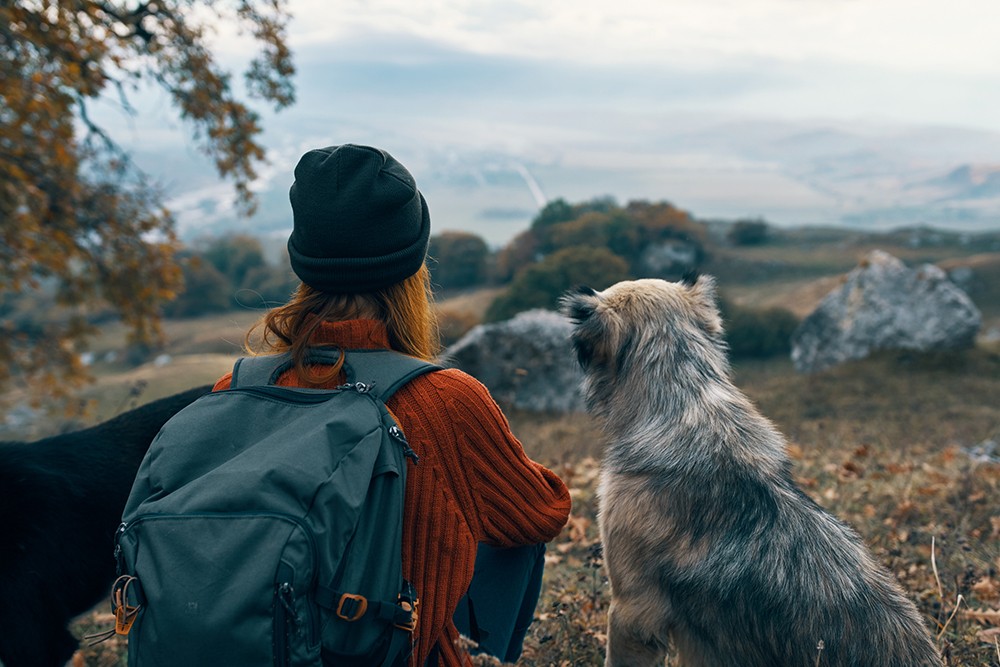Helpful Hints For A Pet Friendly Road Trip

Pets love to travel with their humans. Taking a few basic precautions will ensure both of you enjoy a fun, happy road trip.
Our 13 Tips cover some of the basic items that are easy to forget and some of the not-so-obvious “to-dos” to consider before a road trip with canine companions.
We humbly submit our list of reminders and useful take-alongs to assure a happy outdoor adventure for you and your four-legged pal.
1. Get A Certificate of Veterinary Inspection.
Are you furry travelers up-to-date on their rabies, distemper, canine parvovirus and canine hepatitis shots? Some states and airlines may require proof of pet vaccination called a “certificate of veterinary inspection.”
Also, prepare for travel with copies of your dog’s medical records. Make sure your records indicate vaccinations and dates. Documentation helps whenever you need veterinary care or if you want to board your pet in a pet hotel.
Learn more:
Certificate of Veterinary Inspection
Pet Travel Guidelines from American Veterinary Medical Association
2. National Parks and pets
The National Park Service is pet friendly, yet regulations at national parks vary. Dogs are not necessarily allowed everywhere their humans can go. Do some research on the specific parks and locations you are traveling.
Learn more:
3. For canines and their humans who love to swim
Talk to your vet before you and your pet go for a summer swim. Leptospirosis is a water-borne virus which can cause severe illness.
The bacteria that causes it can be found anywhere, especially in warm areas with heavy rainfall, the AKC states. Although it tends to be found in stagnant water, leptospirosis can also be found in lakes, streams and rivers.
A Leptospirosis vaccine can protect your dog for up to 12 months.
Learn more:
4. Getting social with other dogs?
Bordetella is a bacteria which causes upper respiratory disease generally known as kennel cough. It is highly contagious and may be transmitted whenever groups of dogs meet, like at a campground or boarding facility.
AKC recommends Bordetella vaccine for adult dogs before travelling. It also recommends an annual vaccination to prevent infection.
Learn more:
AKC Five Facts Regarding Bordetella Vaccine
5. Travels to the Great White North
Canada requires dogs older than eight months to have proof of rabies vaccination. Dogs older than three months must have a rabies vaccination certificate, the US Department of Agriculture states. U.S. residents are limited to bringing two dogs into Canada.
Learn more:
6. Pets lost, then found
The American Kennel Club suggests bringing a photo of your pet if they get separated. It also recommends the “old schools” method of identification: a collar with tags with the pet’s name and a way to contact you immediately.
Microchipping also offers a great way for vets and animal control agencies to reunite lost pets. Remember, it requires taking the lost pet to a facility to read the chip. The downside: Getting the microchip scanned by a vet takes time, especially if the nearest vet is hours away.
Traditional collars help reduce that time between lost and eventually found, which reduces anxiety for you and your four-legged friend.
Learn more:
7. Restrain your pet
Letting your dog the freedom to roam around in the vehicle cabin puts them at great risk, especially if your vehicle makes a sudden stop. For small dogs, consider a car seat using a standard seatbelt to keep it locked into place. For larger breeds, look into a clip connecting their collar to a seatbelt latch or a web-like mesh separating the front and back seats.
Learn more:
8. Tips for crates, carriers
Make sure your pet’s carrier is well-ventilated and keeps them cool, according to the Humane Society. Crates should be large enough for them to sit, lie down or stand. Carriers should also be secured with a seatbelt or truck ties.
Learn more:
9. Protect your pet’s eyes
A pet with its head extended out of the car window and tongue flopping happily in the breeze makes for a great photo or Tik Tok video. But it also creates problems for your pet’s eyes. Dogs can develop cataracts and get debris in their eyes when exposed to high winds while you are driving down the highway, PetMd states.
Learn more:
10. Don’t keep your pet in an unattended car
Some cities and towns make it a crime to leave an animal alone in a vehicle. The temperature inside a closed vehicle can reach 100°F in less than 20 minutes, according to the SPCA and other pet welfare groups. If you need to park your vehicle, take the pets with you or have a family member stay with them.
11. Paws and hot surfaces
Walkways such as asphalt, concrete, sand and sun-baked hiking trails can burn your dog’s feet quickly. Bring a towel or blanket for them to lay on if you’re going to a beach, stream or lake.
Use pet shoes and Paw Wax to protect your pets from hot surfaces, recommends Shallowford Pet Hospital in North Carolina.
Learn more:
Protect Paws from Hot Surfaces
12. Bring plenty of water and extra food:
Collapsible water and food dishes are a great idea for anyone who takes their pets camping.
Whether you go by car or hike to a secluded spot, folding dishes let you hydrate and feed your pets without taking up a lot of room in your daypack or vehicle cabin.
13. Foods Your Pet Should Not Eat.
Some human foods are deadly to dogs. Leading the “never feed” list according to the SPCA are onions, garlic, caffeine, grapes and raisins, macadamia nuts and other nuts, artificial sweeteners especially those with Xylitol, chocolate, fat trimmings and bones, yeast dough and fruit with pits or seeds.
Additional Sources:
US Department of Agriculture (pet travel across borders)
SPCA (traveling with pets)
National Park Service (pet guidelines)
Humane Society (pet travel)
PetMD (pet eye protection)